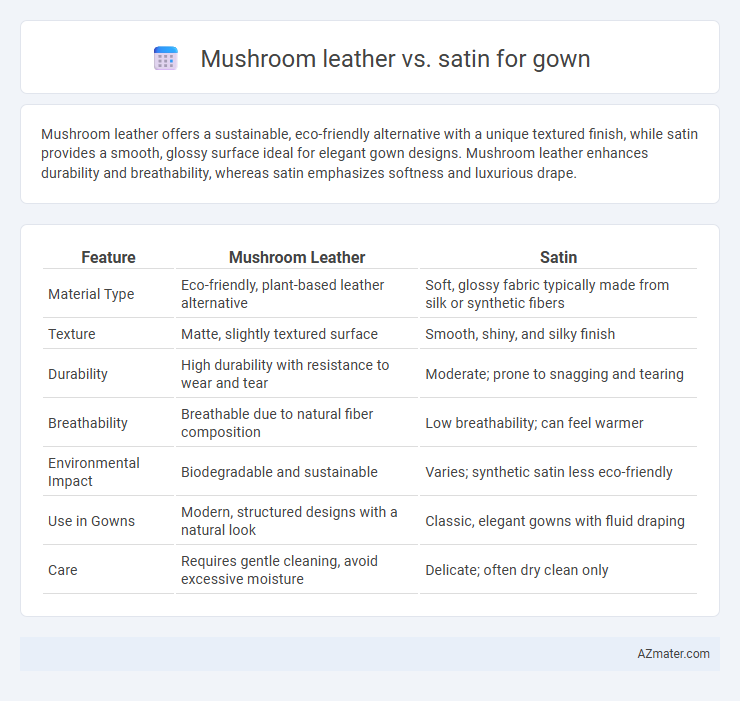Mushroom leather offers a sustainable, eco-friendly alternative with a unique textured finish, while satin provides a smooth, glossy surface ideal for elegant gown designs. Mushroom leather enhances durability and breathability, whereas satin emphasizes softness and luxurious drape.
Table of Comparison
| Feature | Mushroom Leather | Satin |
|---|---|---|
| Material Type | Eco-friendly, plant-based leather alternative | Soft, glossy fabric typically made from silk or synthetic fibers |
| Texture | Matte, slightly textured surface | Smooth, shiny, and silky finish |
| Durability | High durability with resistance to wear and tear | Moderate; prone to snagging and tearing |
| Breathability | Breathable due to natural fiber composition | Low breathability; can feel warmer |
| Environmental Impact | Biodegradable and sustainable | Varies; synthetic satin less eco-friendly |
| Use in Gowns | Modern, structured designs with a natural look | Classic, elegant gowns with fluid draping |
| Care | Requires gentle cleaning, avoid excessive moisture | Delicate; often dry clean only |
Introduction: The Evolution of Sustainable Gown Fabrics
Mushroom leather, derived from mycelium, offers a biodegradable and eco-friendly alternative to traditional satin used in gowns, reducing reliance on synthetic fibers and animal products. This innovative material combines durability with a unique texture that provides a modern aesthetic while aligning with sustainable fashion trends. Sustainable gown fabrics are evolving as designers prioritize environmental impact, integrating materials like mushroom leather to redefine luxury and responsibility in evening wear.
What is Mushroom Leather?
Mushroom leather is an innovative, sustainable material crafted from mycelium, the root structure of mushrooms, offering an eco-friendly alternative to traditional leathers. It features a unique texture that is both durable and lightweight, making it suitable for fashion applications like gowns where structure and comfort are essential. Compared to satin, mushroom leather provides a more textured, earthy aesthetic with enhanced durability and water resistance, while satin is prized for its smooth, glossy finish and fluid drape.
Understanding Satin: Origins and Characteristics
Satin, originally woven from silk in ancient China, is known for its smooth, glossy surface and lustrous sheen created by a weave that produces a high number of warp yarn floats. This luxurious fabric is lightweight, drapes elegantly, and is highly favored for gowns due to its fluidity and reflective quality that enhances formal attire. Unlike mushroom leather, which offers a sustainable, textured alternative made from fungal mycelium, satin's traditional silk composition emphasizes softness and visual appeal over durability and eco-friendliness.
Comparing Texture: Mushroom Leather vs Satin
Mushroom leather offers a unique, matte texture that combines durability with a subtle, natural grain, providing an eco-friendly alternative to traditional materials. Satin, on the other hand, is characterized by its smooth, glossy finish that reflects light, creating a luxurious and elegant appearance ideal for formal gowns. While mushroom leather adds structure and a modern edge, satin delivers softness and fluidity, making texture a key factor when selecting fabric for gown design.
Visual Appeal: Shine, Color, and Aesthetics
Mushroom leather offers a matte, organic texture with muted, earthy tones that create a contemporary, eco-friendly aesthetic, contrasting the high-gloss, smooth finish of satin which provides vibrant color depth and luxurious shine. Satin's reflective surface enhances light play, making gowns appear more elegant and formal, while mushroom leather's subtle sheen lends a sophisticated, modern edge ideal for avant-garde designs. The choice between mushroom leather and satin significantly impacts the gown's visual appeal, balancing between understated natural beauty and classic, luminous glamour.
Comfort and Wearability for Formal Gowns
Mushroom leather offers exceptional breathability and flexibility, making it a comfortable choice for formal gowns that require both structure and ease of movement. Satin, known for its smooth and silky texture, provides a luxurious feel but can sometimes trap heat and restrict airflow, impacting overall wearability during long events. For formal gowns prioritizing all-day comfort and adaptability, mushroom leather combines durability with a modern, breathable design that outperforms satin in maintaining comfort without compromising elegance.
Durability and Maintenance Needs
Mushroom leather offers superior durability compared to satin, resisting tears and abrasion while maintaining its structure over time, making it ideal for long-lasting gowns. Satin requires careful maintenance due to its delicate fibers prone to snagging and discoloration, necessitating gentle cleaning and storage to preserve its smooth texture. Mushroom leather's water resistance and ease of cleaning reduce upkeep efforts, whereas satin demands more frequent professional care to maintain its luxurious appearance.
Sustainability: Environmental Impact Compared
Mushroom leather, derived from mycelium, offers a highly sustainable alternative to satin by utilizing renewable fungi resources and producing minimal waste during manufacturing. Satin, often made from polyester or silk, involves intensive water, pesticide use, and contributes to synthetic microplastic pollution when based on synthetic fibers. Choosing mushroom leather for gowns significantly reduces environmental impact by lowering carbon emissions and promoting biodegradable material usage.
Cost Analysis: Affordability of Both Materials
Mushroom leather offers a sustainable and innovative alternative to traditional fabrics but tends to be priced higher due to its eco-friendly production process and limited availability. Satin remains a cost-effective choice for gowns, widely accessible and produced at scale, resulting in lower retail prices. When balancing affordability, satin provides budget-friendly options, while mushroom leather appeals to consumers prioritizing sustainability despite a higher cost.
Decision Guide: Choosing the Right Fabric for Your Gown
Mushroom leather offers a sustainable, vegan alternative with a luxurious texture and durability ideal for modern gowns, while satin provides a classic, silky sheen and smooth drape perfect for traditional, elegant designs. Consider the gown's purpose; mushroom leather suits edgy, eco-conscious fashion statements, whereas satin excels in formal, timeless aesthetics. Assess comfort, breathability, and maintenance preferences to select the fabric that aligns best with your style and event requirements.

Infographic: Mushroom leather vs Satin for Gown
 azmater.com
azmater.com